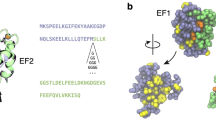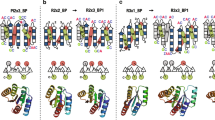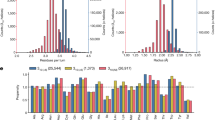Abstract
We have designed de novo 13 divergent spectrin SH3 core sequences to determine their folding properties. Kinetic analysis of the variants with stability similar to that of the wild type protein shows accelerated unfolding and refolding rates compatible with a preferential stabilization of the transition state. This is most likely caused by conformational strain in the native state, as deletion of a methyl group (Ile→Val) leads to deceleration in unfolding and increased stability (up to 2 kcal mol−1). Several of these Ile→Val mutants have negative φ‡−U values, indicating that some noncanonical φ‡−U values might result from conformational strain. Thus, producing a stable protein does not necessarily mean that the design process has been entirely successful. Strained interactions could have been introduced, and a reduction in the buried volume could result in a large increase in stability and a reduction in unfolding rates.
This is a preview of subscription content, access via your institution
Access options
Subscribe to this journal
Receive 12 print issues and online access
$189.00 per year
only $15.75 per issue
Buy this article
- Purchase on Springer Link
- Instant access to full article PDF
Prices may be subject to local taxes which are calculated during checkout







Similar content being viewed by others
References
López de la Paz, M., Lacroix, E., Ramírez-Alvarado, M. & Serrano, L. De novo automatic design of β-sheet model peptides. J. Mol. Biol. 312, 229–246 (2001).
Pokala, N. & Handel, T.M. Review: protein design — where we were, where we are, where we're going. J. Struct. Biol. 134, 269–281 (2001).
Dobson, C.M. Protein misfolding, evolution and disease. Trends Biochem. Sci. 24, 329–332 (1999).
Oliveberg, M. Characterisation of the transition states for protein folding: towards a new level of mechanistic detail in protein engineering analysis. Curr. Opin. Struct. Biol. 11, 94–100 (2001).
Musacchio, A., Noble, M., Pauptit, R., Wierenga, R. & Saraste, M. Crystal structure of a src-homology 3 (SH3) domain. Nature 359, 851–855 (1992).
Viguera, A.R., Martinez, J.C., Filimonov, V.V., Mateo, P.L. & Serrano L. Thermodynamic and kinetic analysis of the SH3 domain of spectrin shows a two-state folding transition. Biochemistry 33, 2142–2150 (1994).
Viguera, A.R., Jimenez, M.A., Rico, M. & Serrano, L. Conformational analysis of peptides corresponding to β-hairpins and a β-sheet, that represent the entire sequence of α-spectrin SH3-domain. J. Mol. Biol. 255, 507–521 (1995).
Martinez, J.C. & Serrano, L. The folding transition-state between SH3 domains is conformationally restricted and evolutionarily conserved. Nature Struct. Biol. 6, 1010–1016 (1999).
Pisabarro, M.T. & Serrano, L. Rational design of specific high-affinity peptide ligands for the Abl-SH3 domain. Biochemistry 35,10634–10640 (1996).
Lacroix E. Protein Design: a Computer-based Approach. PhD thesis, Univ. Libre de Bruxelles (1999).
Fisinger, S., Serrano, L. & Lacroix, E. Computational estimation of specific side chain interaction energies in α-helices. Protein Sci. 10, 809–818 (2001).
Reina, J. et al. Computer-aided design of a PDZ domain to recognize new target sequences. Nature Struct. Biol. In the press (2002).
Shortle, D., Strites, W.E. & Meeker, A.K. Contributions of the large hydrophobic amino acids to the stability of staphylococcal nuclease. Biochemistry 29, 8033–8041 (1990)
Sandberg, W.S. & Terwilliger, T.C. Energetics of repacking of a protein interior. Proc. Natl. Acad. Sci. USA 88, 1706–1710 (1991).
Serrano, L., Kellis, J., Cann, P., Matouschek, A. & Fersht, A.R. The folding of an enzyme II. J. Mol. Biol. 224, 783–804 (1992).
Jackson, S.E., Moracci, M., elMasry, N., Johnson, C.M. & Fersht, A.R. Effect of cavity-creating mutations in the hydrophobic core of chymotrypsin inhibitor 2. Biochemistry 32, 11259–11269 (1993).
Fersht, A.R. Characterizing transition states in protein folding: an essential step in the puzzle. Curr. Opin. Struct. Biol. 5, 79–84 (1995).
Riddle, D.S. et al. Experiment and theory highlight role of native state topology in SH3 folding. Nature Struct. Biol. 6, 1016–1024 (1999).
Viguera, A.R. Wilmanns, M. & Serrano, L. Different folding transition states could result in the some native structure. Nature Struct. Biol. 3, 874–880 (1996).
Jackson, S.E., elMasry, N. & Fersht, A.R. Structure of the hydrophobic core in the transition state for folding of chymotrypsin inhibitor 2: a critical test of the protein engineering method of analysis. Biochemistry 32, 11270–11278 (1993).
Ladurner, A.G., Itzhaki, L.S. & Fersht, A.R. Strain in the folding nucleus of chymotrypsin inhibitor 2. Fold Des. 2, 363–368 (1997).
Milla, M.E., Brown, B.M., Waldburger, C.D. & Sauer, R.T. P22 Arc repressor: transition state properties inferred from mutational effects on the rates of protein unfolding and refolding. Biochemistry 34, 13914–13919 (1995).
Khorasanizadeh, S., Peters, I.D. & Roder, H. Evidence for a three-state model of protein folding from kinetic analysis of ubiquitin variants with altered core residues. Nature Struct. Biol. 3, 193–205 (1996).
Desjarlais, J. & Handel, T. De novo design of the hydrophobic cores of proteins. Protein Sci. 10, 2006–2018 (1995).
Munson, M., O'Brien, R., Sturtevant, J.M. & Regan, L. Redesigning the hydrophobic core of a four-helix bundle protein. Protein Sci. 3, 2025–2022 (1994).
Dahiyat, B.I. & Mayo, S.L. Probing the role of packing specificity in protein design. Proc. Natl Acad. Sci. USA 94, 10172–10177 (1997).
Lazar, G.A. et al. De novo design of the hydrophobic core of ubiquitin. Protein Sci. 6, 1167–1178 (1997).
Desjarlais, J.R. & Handel, T.M. Side-chain and backbone flexibility in protein core design. J. Mol. Biol. 290, 305–318 (1999).
Ross, S.A. et al. Designed protein G core variants fold to native-like structures: sequence selection by ORBIT tolerates variation in backbone specification. Protein Sci. 10, 450–454 (2001).
Gordon, D.B., Marshall, S.A. & Mayo, S.L. Energy functions for protein design. Curr. Opin. Struct. Biol. 9, 509–513 (1999).
Maiorov, V. & Abagyan, R. Energy strain in three-dimensional protein structures. Fold Des. 3, 259–269 (1998).
He, X.L. et al. Crystal structures of two α-like scorpion toxins: non-proline cis peptide bonds and implications for new binding site selectivity on the sodium channel. J. Mol. Biol. 292, 125–135 (1999).
Vega, M.C., Martinez, J.C. & Serrano, L. Thermodynamic and structural characterization of Asn and Ala residues in the disallowed II′ region of the Ramachandran plot. Protein Sci. 9, 2322–2328 (2000).
Goldenberg, D.P. Finding the right fold. Nature Struct. Biol. 6, 987–990 (1999).
Ozkan, S.B., Bahar, I. & Dill, K.A. Transition states and the meaning of Phi-values in protein folding kinetics. Nature Struct. Biol. 8, 765–769 (2001).
Northey, J.G.B., DiNardo, A.A. & Davidson, A.R. Hydrophobic core packing in the SH3 domain folding transition state. Nature Struct. Biol. 9, 126–130 (2002).
Otwinosky, Z. Proceedings of the CCP4 Study weekend (Daresbury Laboratory, UK; 1993).
Navaza, J. AMoRe: an automated package for molecular replacement. Acta Crystallogr. A 50, 157–163 (1994).
Brünger, A.T. Free R-value: a novel statistical quantity for assessing of crystal structure. Nature 355, 472–475 (1992).
Nemethy, G., Pottle, M.S. & Scheraga, H.A. Updating of geometrical parameters, nonbonded interactions and hydrogen bond interactions for the naturally occurring amino acids. J. Phys. Chem. 87, 1883–1887 (1983).
Koehl, P. & Delarue, M.A. A self consistent mean field approach to simultaneous gap closure and side chain positioning in homology modelling. Nature Struct. Biol. 2, 163–170 (1995).
Street, A.G. & Mayo, S.L. (1998). Pairwise calculation of protein solvent-accessible surface areas. Folding & Design 3, 253–258.
Eisenberg, D. & McLachlan, A.D. Solvation energy in protein folding and binding. Nature 319, 199–203 (1986).
Thompson J.D., Higgins D.G. & Gibson T.J. CLUSTALW: improving the sensitivity of progressive multiple sequence alignment through sequence weighting position-specific gap penalties and weight matrix choice. Nucleic Acids Res. 22, 4673–4680 (1994).
Larson, S.M., Di Nardo, A.A. & Davidson, A.R. Analysis of covariation in an SH3 domain sequence alignment: applications in tertiary contact prediction and the design of compensating hydrophobic core substitutions. J. Mol. Biol. 303, 433–436.
Thompson, J.D., Gibson, T.J., Plewniak, F., Jeanmougin, F. & Higgins, D.G. The ClustalX windows interface: flexible strategies for multiple sequence alignment aided by quality analysis tools. Nucleic Acids Res. 24, 4876–4882 (1997).
Schultz, J., Milpetz, F., Bork, P. & Ponting C.P. SMART, a simple modular architecture research tool: identification of signaling domains. Proc. Natl. Acad. Sci. USA 95, 5857–5864 (1998).
Filimonov, V.V., Azuaga, A.I., Viguera, A.R., Serrano, L. & Mateo, P.L. A thermodynamic analysis of a family of small globular proteins: SH3 domains. Biophys. Chem. 77, 195–208 (1999).
Rath, A. & Davidson, A.R. The design of a hyperstable mutant of the Abp1p SH3 domain by sequence alignment analysis. Protein Sci. 9, 2457–2469 (2000).
Chen, Y.J. et al. Stability and folding of the SH3 domain of Bruton's tyrosine kinase. Proteins 26, 465–471 (1996).
Lim, W.A., Fox, R.O. & Richards, F.M. Stability and peptide binding affinity of an SH3 domain from the Caenorhabditis elegans signaling protein Sem-5. Protein Sci. 3, 1261–1266 (1994).
Zhang, O., Kay, L.E., Olivier, J.P. & Forman-Kay, J.D. Backbone 1H and 15N resonance assignments of the N-terminal SH3 domain of drk in folded and unfolded states using enhanced-sensitivity pulsed field gradient NMR techniques. J. Biomol. NMR 4, 845–858 (1994).
Acknowledgements
C. Vega was supported by a Marie Curie fellowship. This work was partly supported by an EU Biotech grant. We are very grateful to M. DelaPaz for her critical comments.
Author information
Authors and Affiliations
Corresponding author
Ethics declarations
Competing interests
The authors declare no competing financial interests.
Rights and permissions
About this article
Cite this article
Ventura, S., Cristina Vega, M., Lacroix, E. et al. Conformational strain in the hydrophobic core and its implications for protein folding and design. Nat Struct Mol Biol 9, 485–493 (2002). https://doi.org/10.1038/nsb799
Received:
Accepted:
Published:
Issue Date:
DOI: https://doi.org/10.1038/nsb799
This article is cited by
-
Multifactorial level of extremostability of proteins: can they be exploited for protein engineering?
Extremophiles (2017)
-
Manipulation of the Conformation and Enzymatic Properties of T1 Lipase by Site-Directed Mutagenesis of the Protein Core
Applied Biochemistry and Biotechnology (2012)
-
Structural adaptation of extreme halophilic proteins through decrease of conserved hydrophobic contact surface
BMC Structural Biology (2011)
-
Structural characterization of a misfolded intermediate populated during the folding process of a PDZ domain
Nature Structural & Molecular Biology (2010)



